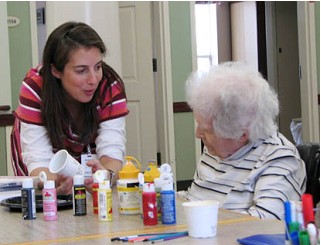Here’s a gratifying story about how art therapy is helping older adults and seniors find new ways to express themselves. With a combination of art therapy, religion, and various other Jewish themes, the art therapy group at Village Shalom are finding ways to communicate their deepest, and sometimes darkest, feelings…
**The following press release was originally written by Cathy Malchiodi, ATR-BC, Professional Relations for American Art Therapy Association (AATA).
“Torah Portion Art Therapy” and Older Adults
Drawing on Beliefs and Memories Enriches Lives through Artistic Self-Expression
 Across the US, more older adults are experiencing the benefits of self-expression. Recent studies indicate that the arts in general have health benefits including physical, social, and emotional well-being and improvement of symptoms associated with common ailments associated with aging. An art therapy group at Village Shalom resembles countless others at retirement communities and nursing homes across the country. But what sets it apart is its specific focus on Jewish themes, holidays and the weekly Torah portion. Art therapist Sherri Jacobs welcomes everyone and explains the project for the day. “We’re making an Elijah’s cup, and we’re also going to practice the Four Questions for the Passover seder, which is coming up in just a couple of weeks,” she says. Each participant receives a plaster-coated plastic cup lettered in Hebrew with the words “Kos Eliyahu” (cup of Elijah). Participants choose their favorite paint colors and soon everyone is engrossed and engaged in artistic expression.
Across the US, more older adults are experiencing the benefits of self-expression. Recent studies indicate that the arts in general have health benefits including physical, social, and emotional well-being and improvement of symptoms associated with common ailments associated with aging. An art therapy group at Village Shalom resembles countless others at retirement communities and nursing homes across the country. But what sets it apart is its specific focus on Jewish themes, holidays and the weekly Torah portion. Art therapist Sherri Jacobs welcomes everyone and explains the project for the day. “We’re making an Elijah’s cup, and we’re also going to practice the Four Questions for the Passover seder, which is coming up in just a couple of weeks,” she says. Each participant receives a plaster-coated plastic cup lettered in Hebrew with the words “Kos Eliyahu” (cup of Elijah). Participants choose their favorite paint colors and soon everyone is engrossed and engaged in artistic expression.
Jacobs explains, “In working with the elderly, it is sometimes hard to get them to express themselves. There are a lot of trust issues in getting the people to share and open up. Using art therapy and a Jewish theme helps as a springboard for them to talk about their feelings on such things as mortality, grief, dreams, loss of opportunity, loneliness, self-esteem, and depression.”
Perhaps one of the most memorable sessions was one Jacobs conducted with a group of Holocaust survivors several years ago around the time of Yom HaShoah (Holocaust Remembrance Day). “I brought some small boxes for them to decoupage with pictures and stickers, inside and out,” she recalls. The exterior of the box was intended to represent the individual’s outward self; the interior was to express the innermost emotions and recollections of the Holocaust experience. “Every single participant put a picture of a key inside their box,” she says. “The one thing every survivor had was a key to their house, because they thought they would be able to go back home when the Holocaust was all over.”
Village Shalom is honored to be a 2007 and 2008 recipient of the PEAK award (Promoting Excellent Alternatives in Kansas long-term care) from the Kansas Department on Aging. The award is given in recognition of the organization’s commitment to providing resident-centered care that values each individual’s quality of life as well as quality of care.
can you point me to names of researchers/titles of research /recent studies that you suggest in your article that show the health benefits of of the arts in all areas you note above?
I am very interested in reading more in this area.